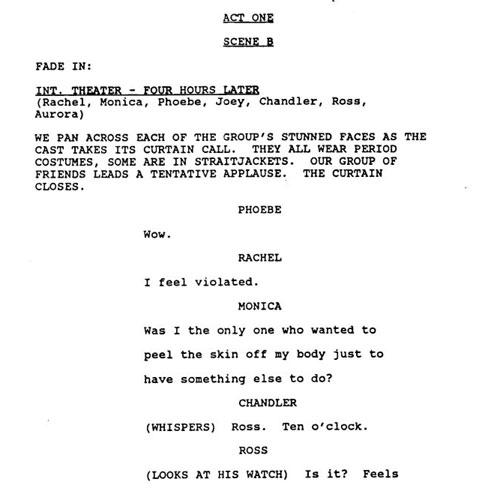

Keep your audience on the edge of their seats by using the act breaks (or commercial breaks) as cliffhangers. You need to create a big impression in the pilot.ĭepending on if you are writing a half hour or an hour show, you are going to separate your script into three or six acts. Don’t try to do too much, or the show will feel muddled and leave the audience confused.Ī good general rule is to introduce an A story and a B story, then resolve both stories within that episode. The pilot should introduce your show’s world and its core characters, give a taste of back story and create an episode template that clearly marks the show's tone. Keep it simpleīe careful not to overwhelm your audience in the first episode. Remember, you want your characters to be as dynamic as possible on screen to make the best possible use of your visual stage. What is the setting? What will the characters be wearing, will they be sitting still, entering or exiting, being active?


Television is visual, so as you are writing your script, consider the visual context of your scenes. Reading aloud as you write will also help produce lines that flow naturally. Once you’ve developed your character’s traits, quirks and background, make sure their dialogue embodies that “voice” you have created in your head. The key to writing a compelling character is to give them a clear and unique voice. Your cast is even more important than plot in a pilot episode because if the audience fails to connect to the characters, they won't tune in again. Start With an Outlineīefore you write your script, it helps to start with an outline of the basic elements, including the overall story arc and individual scene descriptions.Īn outline will help you shape your story, and point out any holes before you jump into developing the dialogue.
#TV PILOT TEMPLATE HOW TO#
Download this kit to get expert tools that will help you create a logline, plot, and acts.Įnter your email below to download the free How to Write a TV Pilot kit.Photo by Angel Raul Ravelo Rodriguez 1. This is your chance to start the television writing career you’ve always wanted and learn how to write a TV pilot. Even if you’ve never written a TV pilot before, you will be able to tackle the task with our tips at your side. Once you have a handle on the foundation of your TV pilot, you’ll gain the confidence to write your own. This TV pilot kit will launch you into your television writing career by teaching you the basics you need to pitch a TV show.
#TV PILOT TEMPLATE SERIES#
This tool will show you how to build a road map for your TV series in order to give executives what they crave-a television show concept they can sell. The Industry Insider TV Pilot Proposal template shares the must-have qualities your television proposal needs to attract the right buyer. You need characters to drive the story and make the reader want to follow them on their journey of 100 episodes or more. To understand how to become a screenwriter for TV, you need to master the basics of writing a TV proposal. Writing a television proposal is more than just plot points. We’ve also provided a completed proposal using How I Met Your Mother characters to illustrate what a finished template looks like and what you should include. Scared of a blank page staring at you? Breaking into TV writing begins with your concept for a television show. The TV Pilot Kit includes an Industry Insider TV Pilot Proposal template you can use to create a foundation to launch your television idea from. Knowing your characters and their relationships with each other will bring your story idea to life and generate enough ideas for conflicts to write a fully fleshed out proposal for a TV show.Ĭlick here to tweet this free download with your friends and followers! How to Write a TV Pilot Proposal Without a unique and original concept, your television show won’t be marketable. With our Character Relationship Map you’ll be able to build characters interesting enough to sustain a television series as well as attract top television actors.


 0 kommentar(er)
0 kommentar(er)
